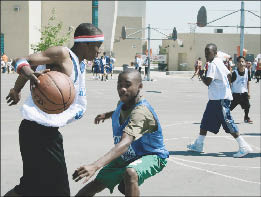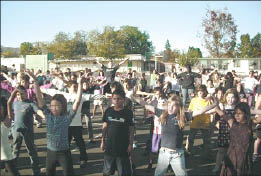 |
|
Youths face off in ASAS-LA’s annual “March Madness” basketball tournament. Boys and girls teams scrimmage all year to qualify for the playoffs.
Photo: ASAS-LA |
After-School All-Stars
Los Angeles
(323) 957-4426
http://www.la-allstars.org
The Strategy: Provide after-school activities for middle and high school youth that revolve around health, fitness and nutrition; the visual and performing arts; and youth leadership and community service-learning.
Getting Started: Founded in 2002, After-School All-Stars, Los Angeles (ASAS-LA) was designed to provide programs to educate, enlighten and inspire students each day through after-school activities. (For more on the history of the program, which was buoyed by the involvement of California Gov. Arnold Schwarzenegger, see “Arnold Learns Youth Work.”)
How It Works: The school-based programs offer activities for youth with different preferences, experiences and levels of physical fitness and skill. Participants at 21 Los Angeles County schools may choose from activities in the performing arts, culinary arts, team sports and nontraditional tournaments. More traditional offerings include basketball, football, baseball, soccer and cheerleading. Other activities include skateboarding, capoiera, track and field, yoga and fencing.
Youth Served: ASAS-LA serves 3,500 students per day and around 10,000 children throughout the school year; they hail from disadvantaged areas throughout Los Angeles County. All participating schools must be in “program improvement stage,” which means the schools have a high percentage of youth who qualify for free lunch and their students have low test scores. The vast majority of the youths’ families are at or below the federal poverty level. Eighty-five percent are Hispanic, 9 percent are African-American, 7 percent are Caucasian and 3 percent are Asian.
Staff: ASAS-LA has 200 employees who implement programs at the schools. That includes program leaders, who are the front-line staff members who work directly with youth; site assistants, who also work with youth; and site coordinators, who are full-timers who manage all levels of program logistics and serve as liaisons between the school administrations and ASAS-LA staff.
Money: Public grants and private contributions. The majority of the group’s fiscal 2009 overall revenue stream of nearly $4.5 million came from government contracts, in particular a five-year 21st Century Community Learning Center ASSETS grant.
Woodcraft Rangers Nvision Afterschool Club Program
Los Angeles, Calif.
(213) 249-9293, ext. 231
http://www.woodcraftrangers.org
 |
|
A fitness challenge at an elementary school.
Photo: Woodcraft Rangers |
The Strategy: Engage 6- to 18-year-olds in enjoyable and stimulating group activities that improve their academic performance and increase their life skills.
Getting Started: The Los Angeles Woodcraft Rangers was founded in 1915 and incorporated as a nonprofit in 1922. Woodcraft’s organizational goals are to reduce risk factors affecting children and increase their chances for success in school and in life. Woodcraft started Nvision in 1992.
How It Works: The year-round program meets on elementary, middle and high school campuses five days a week, from class dismissal to 6 p.m. The program begins with a 45-minute homework clinic that includes support from staff and volunteers. Next comes a brief fitness period with snacks, followed by various activities organized by “clubs” that differ from site to site. The clubs run in eight-week cycles.
Examples of clubs are Cir-Kitz, which takes youths through a series of 10 to 30 exercise stations that include jumping rope, sprints, squats, lunges and jumping jacks; Zenergy, a yoga-based program; an action-based video game club that features Wii Fit, Wii Sports and Dance Dance Revolution; Top Chefs, which teaches culinary arts; and gardening.
Youth Served: The agency works on 36 elementary school, 17 middle school and three high school campuses. Woodcraft reports that last year it served more than 18,000 youth. Most were Latino (84 percent), followed by African-American (6 percent), Asian/Pacific Islanders (7 percent), and Caucasian and others (3 percent). Gender participation is just about equal. Most of the youths qualify for free or reduced-price meals.
Staff: Programs are run by club leaders, with a ratio of 20 students to a leader. The club leaders are paid adults who each report to a site coordinator in charge of overseeing the program at each location.
Money: The programs are funded by government grants, private foundations and individual donors. Of the nearly $8.5 million in total funding in the past fiscal year, roughly $8.1 million came from the government – mostly from the state ASES program, some from a federal 21st Century Learning Center grants and a little from the local government. Numerous other groups contribute, including the Green Foundation, the Northrop Grumman Foundation and the Boeing Foundation.
Fitness 4 Life
Watsonville, Calif.
(831) 786-2100
The Strategy: Provide well-rounded physical activity and nutrition-based programming for the Pajaro Valley Unified School District’s after-school programs to develop youths’ skills in living healthier futures.
Getting Started: Fitness 4 Life was started in 2004 after the community’s needs were assessed. Joe Trautwein, the school district’s students services director, and Mark Donnelly, an elementary school principal, started the program with the vision of getting youths more active by having them train for triathlons.
How It Works: Operating out of 13 elementary schools, five middle schools and three high schools, Fitness 4 Life engages youth in swimming, biking, salsa and hip-hop dance, soccer and table tennis. The youths participate at their own schools, and once a week are driven to a local high school to work out at a gym, swim and attend nutrition education classes. The physical activities change every nine weeks, for the purpose of training students to take part in an annual two-day triathlon.
The High School Teach Program component provides training in leadership and teaching. After completing their training, the high school student teachers, under direction of adult coaches, deliver instruction to the Fitness 4 Life elementary and middle school students in art, music, science and fitness.
Youth Served: More than 2,000 students each year, ranging from kindergarten through 12th grade, in the communities of Pajaro and Watsonville, Calif. Among the kindergarten through 8th-grade students, 85 percent are Hispanic and 82 percent qualify for free or reduced-price meals.
Staff: Includes one part-time coordinator, four credentialed staff members, 12 enrichment specialists and 25 high school aides. All staff members work 15 to 20 hours a week. The adult-to-youth ratio is 1-to-10.
The credentialed staff and enrichment specialists focus on physical activities and nutrition issues, such as sustainable food systems and healthy behaviors. The enrichment specialists create a curriculum to teach to the high school aides and teach the curriculum with them.
Money: The program has been funded by the S.H. Cowell Foundation, and by the After School Education and Safety program – state government funding administered through the California Department of Education – and by a federal 21st Century Community Learning Center grant. The total operating budget is $366,000 annually.


























